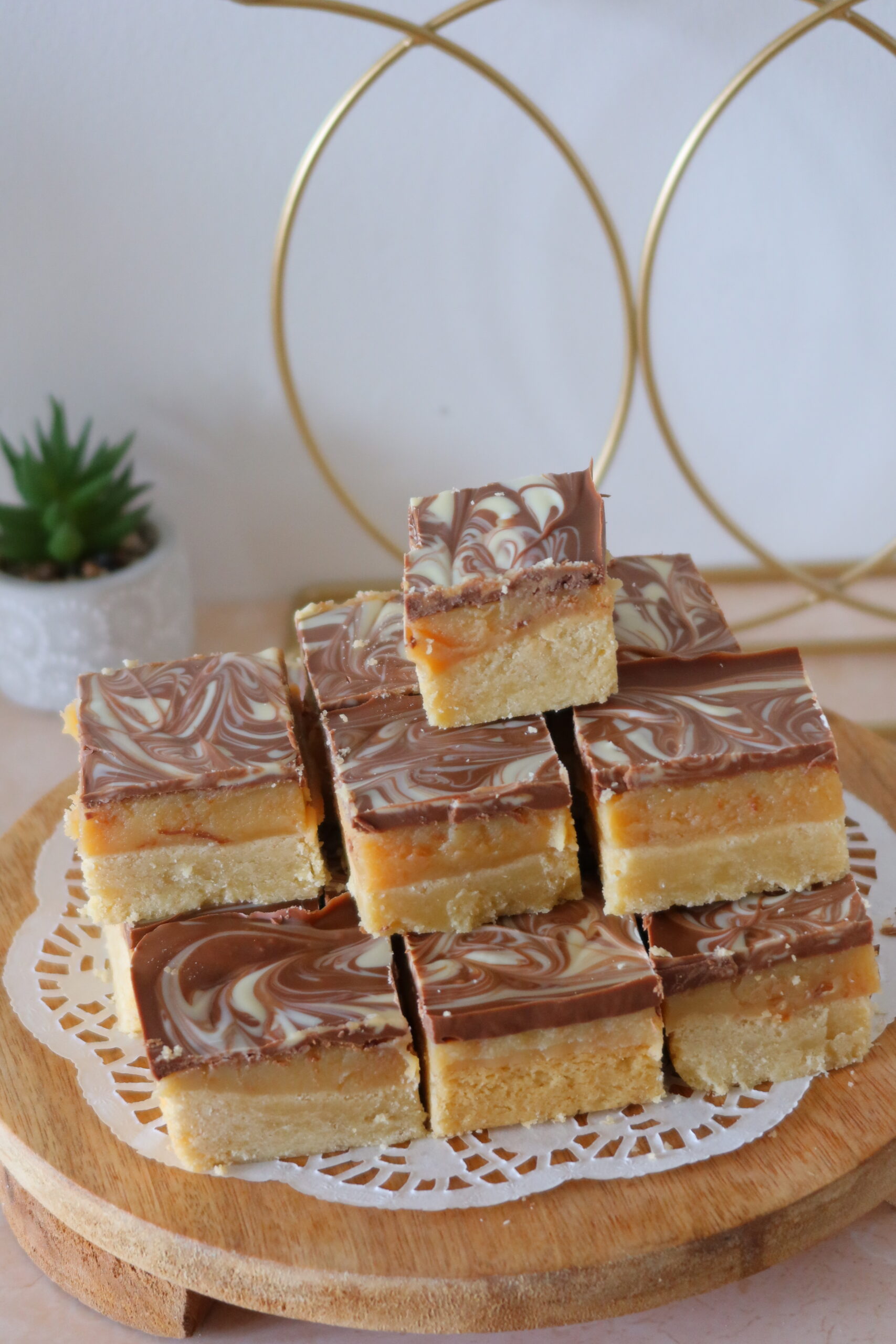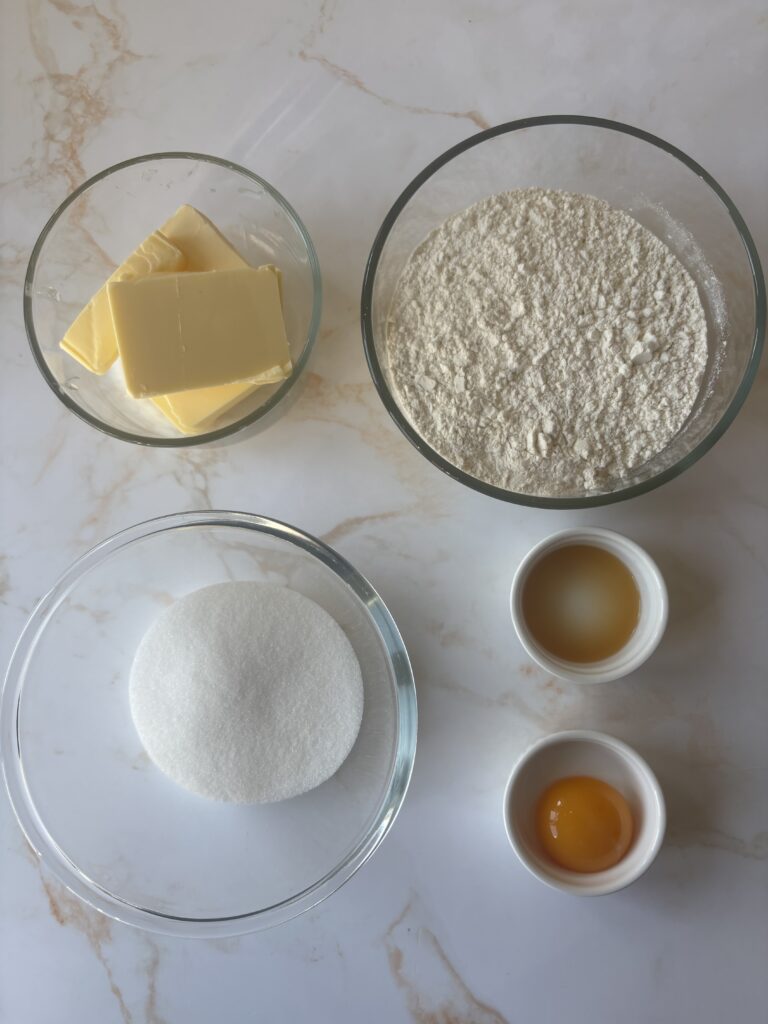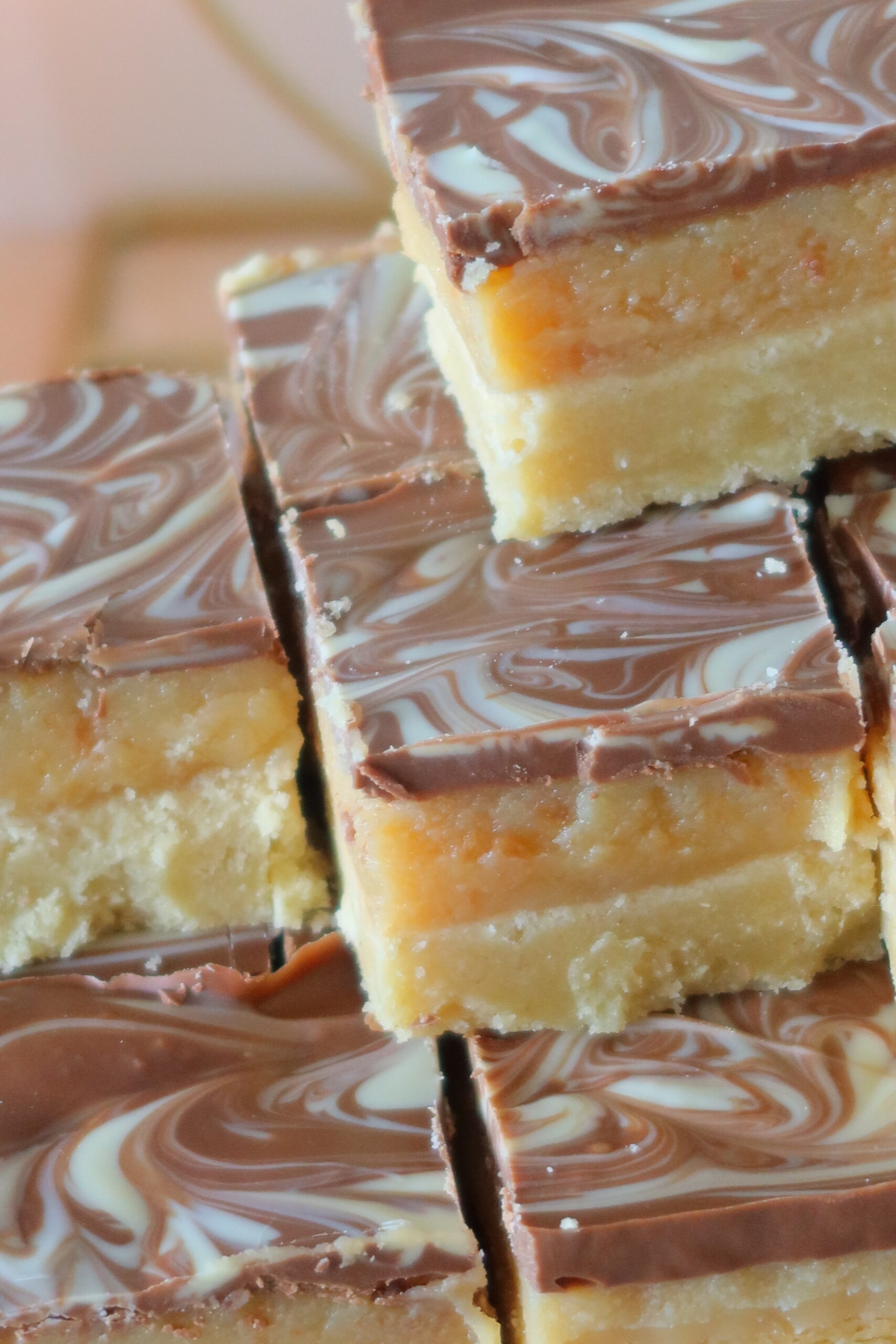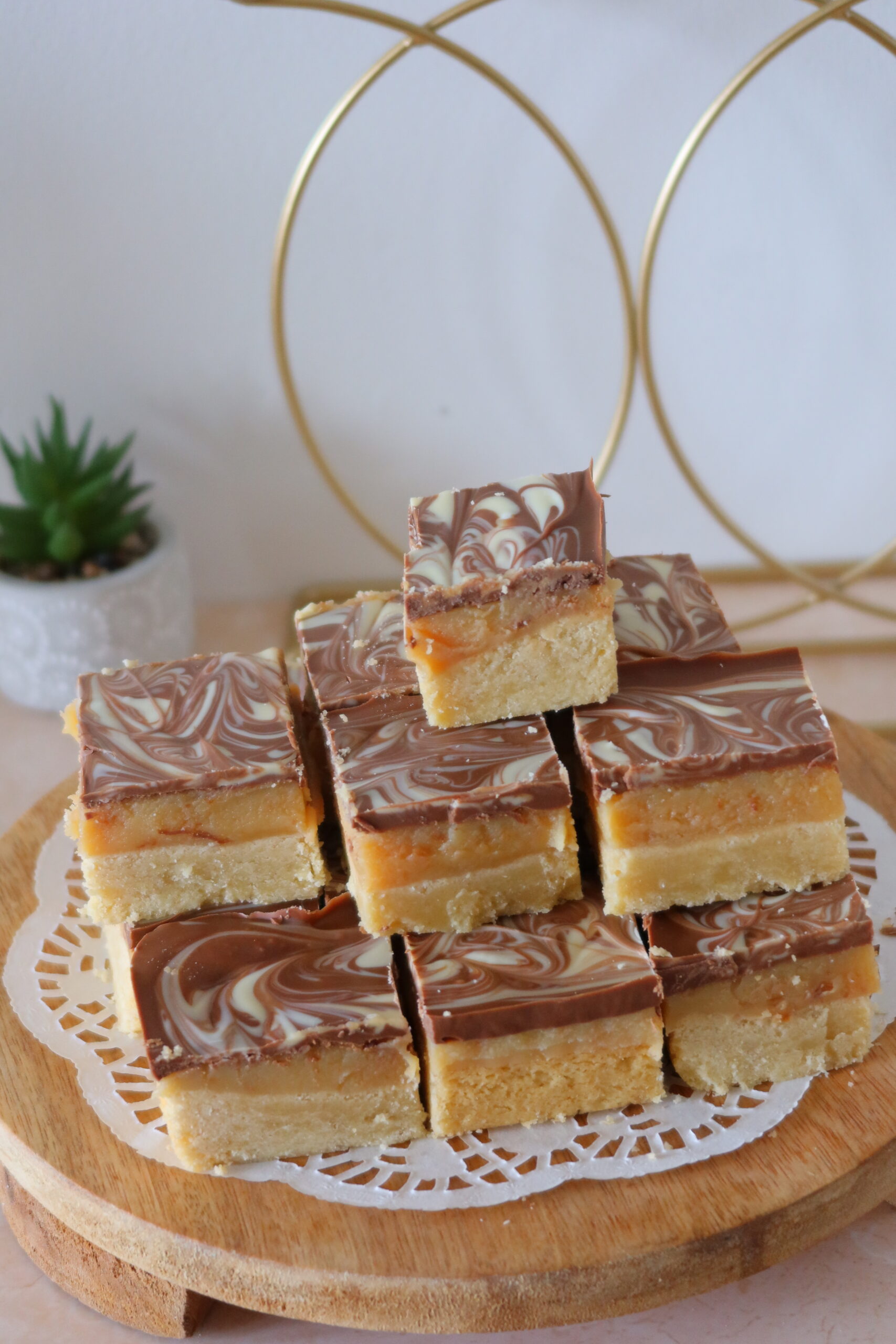Millionaire’s shortbread is an indulgent layered dessert that features a harmonious combination of rich flavors and textures.
It typically starts with a buttery shortbread base, which provides a crisp and slightly crumbly foundation. This layer is generously topped with a smooth and gooey caramel filling, made from rich butter, sweetened condensed milk, and golden syrup, offering a luscious sweetness that perfectly complements the shortbread. Finally, the entire creation is drizzled or spread with a decadent layer of milk or dark chocolate, adding a creamy richness that ties the dessert together.

Millionaire’s Shortbread is generally not considered hard to make, but it does involve multiple steps and layers, which can make it seem a bit more complex than some other desserts. Here is an overview of the process:
Making the Shortbread Base:
This is often the simplest part. You cream together butter and sugar, mix in flour, press the mixture into a baking dish, and bake until golden. It requires minimal ingredients and effort.
Preparing the Caramel Filling:
Making the caramel involves melting butter, condensed milk, golden syrup, and salt together, then cooking it while stirring to achieve the right consistency. This step requires some attention to ensure the caramel doesn’t scorch or stick to the pan, but it’s quite straightforward.
Creating the Chocolate Topping:
Melting chocolate is easy, and you only need to spread it over the set caramel layer. If you want to add drizzles of white chocolate, that requires a bit more melting but is still a simple task.

Everything you need:
- Caster Sugar (100g):
- Function: Caster sugar is a finely granulated sugar that dissolves easily, making it ideal for creating a smooth texture in baked goods. It sweetens the shortbread and helps achieve a nice golden color when baked.
- Unsalted Butter (200g):
- Function: Butter is essential for flavor and moisture in the shortbread. It contributes to the rich, buttery taste characteristic of shortbread. Using unsalted butter allows you to control the overall saltiness of the dessert because you’ll be adding salt in the caramel.
- Plain Flour (280g):
- Function: The flour forms the structure of the shortbread. It provides the necessary gluten that gives the cookie its classic crumbly, yet firm, texture. Using plain flour (all-purpose flour) is typical for shortbread recipes.


Caramel Layer
- Unsalted Butter (200g):
- Function: The butter in the caramel contributes to the creaminess and richness of the filling. It helps create a smooth texture when combined with condensed milk and golden syrup.
- Condensed Milk (397g, one tin):
- Function: Sweetened condensed milk adds both sweetness and a creamy texture to the caramel. It thickens as it cooks, forming the luscious, gooey layer that defines Millionaire’s Shortbread.
- Golden Syrup (4 tbsp):
- Function: Golden syrup adds sweetness and a mild, caramel flavor to the caramel layer. It also helps prevent the sugar from crystallizing during cooking, resulting in a smooth, glossy finish.
- Salt (½ tsp):
- Function: A pinch of salt enhances the flavor of the caramel, balancing the sweetness and deepening the overall taste. It also complements the buttery flavor, making the caramel more flavorful.

Chocolate Topping
- Milk Chocolate (200g):
- Function: The milk chocolate topping provides sweetness and richness, complementing the caramel layer beneath it.
- White Chocolate (75g, optional):
- Function: If used, white chocolate can be drizzled over the milk chocolate for added sweetness and visual appeal.

How to make caramel
Making caramel for the first time can be a bit tricky! I advise to make the caramel from scratch rather than buying a tin of premade Carnations caramel. This is because store bought caramel can vary in consistency – it can often be too runny and will not set.
The caramel will cook very fast in the saucepan when it starts to boil, you will need to continue stirring until the mixture begins to simmer. Place the saucepan over medium heat. Stir constantly with a wooden spoon or a silicone spatula to combine the ingredients well. This helps prevent the mixture from sticking to the bottom of the pan and burning. Be careful not to let it boil vigorously, as this can cause the caramel to burn.
The caramel can take anywhere from 5-10 minutes to start boiling, it’s important to continuously check the consistency. You can use a thermometer to ensure your caramel is at least 110 degrees celsius – 115 degrees celsius (230F – 239F).
Recipe Tips
Stir the caramel: Caramel can go from perfectly cooked to burnt quickly. Stirring helps you monitor the progress and adjust the heat if necessary to avoid burning.
Chill between layers: After making the shortbread base and before adding the caramel, let it cool and chill in the fridge for a bit. This helps the layers set and provides a better structure.
Similarly, chill the caramel layer before pouring the chocolate on top. This prevents the chocolate from melting into the warm caramel.
Using a thermometer: You can use a thermometer to check the caramel reaches the desired consistency. Different stages of caramel development correspond to specific temperatures. Soft ball stage (around 240°F or 115°C): Good for a softer caramel. Hard ball stage (around 250°F or 121°C): Could lead to a firmer caramel.
Cutting technique: For clean cuts, use a hot knife. You can dip it in hot water, dry it off, and then slice through the bars. This helps prevent the chocolate layer from cracking.

More Traybake Recipes:

Luxury Millionaire’s Shortbread
Ingredients
Shortbread
- 100 g caster sugar
- 200 g unsalted butter
- 280 g plain flour
Caramel
- 200 g unsalted butter
- 397 g condensed milk one tin
- 4 tbsp golden syrup
- ½ tsp salt
Chocolate topping
- 200 g milk chocolate
- 75 g white chocolate optional
Instructions
Shortbread
- Preheat your oven to 160°C (320°F) and line a rectangular baking tin (approximately 20×30 cm) with parchment paper, leaving some overhang for easy removal later.
- In a mixing bowl, beat together the softened unsalted butter and caster sugar until the mixture is light and fluffy.
- Sift in the plain flour and mix until just combined. The dough will be crumbly but should hold together when pressed.
- Transfer the mixture into the prepared baking tin and press it down evenly to form a solid base. You can use the back of a spoon or your hands for this.
- Bake in the preheated oven for about 20-25 minutes or until the edges are lightly golden. Remove from the oven and let it cool completely in the tin.
Caramel
- In a saucepan over medium heat, combine the unsalted butter, condensed milk, golden syrup, and salt. Stir continuously to mix well.
- Bring the mixture to a gentle boil, stirring constantly. Continue to cook for about 5-10 minutes until it thickens and turns a golden caramel color. Be cautious not to burn it; you want it thickened but smooth.
- Once thickened, remove the caramel from the heat and pour it over the cooled shortbread base, spreading it evenly. Allow it to cool and set at room temperature or refrigerate it for quicker setting.
Chocolate topping
- In a microwave-safe bowl or over a double boiler, melt the milk chocolate, stirring until it’s smooth.
- Pour the melted milk chocolate over the set caramel layer, spreading it evenly to cover the surface entirely.
- If using, melt the white chocolate and drizzle it over the milk chocolate layer for an attractive finish. Swirl the white chocolate into the milk chocolate using a toothpick or the end of a cake skewer.
- Refrigerate the assembled shortbread until the chocolate is set, typically for at least 2 hours.
Serving and storage
- Once everything is set, use a sharp knife to cut the layered dessert into squares or rectangles. Use the parchment overhang to lift it out of the tin for easier cutting.
- Store the caramel shortbread in an airtight container in the refrigerator. They can last up to a week, but they are best enjoyed within a few days for optimal texture.
